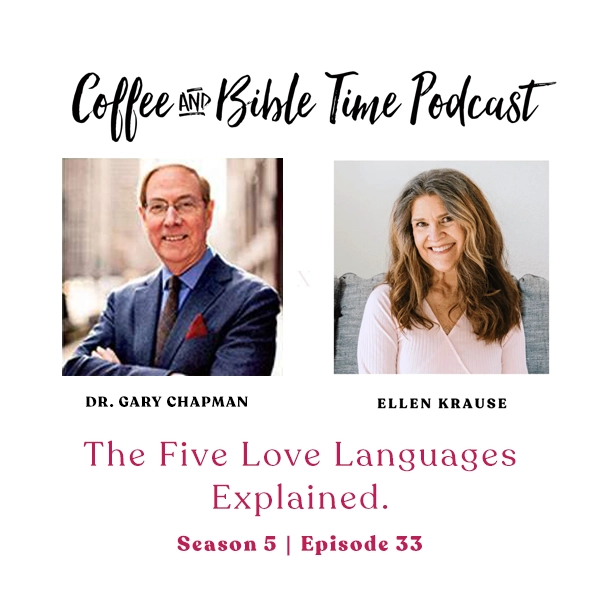As an Amazon Associate, we earn from qualifying purchases.
Hosted by Ellen Krause (Mentor Mama)
The Five Love Languages explained:
What is love—really—and how do we make it last? In this episode, Dr. Gary Chapman (best-selling author of The 5 Love Languages and Love Is a Choice) joins Coffee and Bible Time to share a practical, biblical vision of love that goes beyond feelings. You’ll learn how to communicate love clearly, meet real emotional needs, and build healthier relationships in marriage, family, and friendship.


Chapters:
00:00 Intro — Dr. Gary Chapman joins Coffee & Bible Time
00:45 Guest intro & episode setup
02:15 What is love? Feeling vs. choice
06:50 The “in-love” stage and why it fades
09:40 The Five Love Languages explained: Words of Affirmation
12:30 Acts of Service
15:10 Gifts
17:45 Quality Time
20:15 Physical Touch
22:10 Primary love language & love tank
25:40 How to discover a love language + quiz
29:20 Chapman’s marriage example
32:10 Learn a love language as an adult
35:00 Boundaries, counseling, and tough love
38:10 Empathetic listening (conflict → teamwork)
41:00 Stories from Love Is a Choice
44:00 Resources & close

For decades, Dr. Gary Chapman has helped couples, families, and friends build deeper emotional connection through a simple idea: we tend to give and receive love in different ways. His framework—often called the Five Love Languages—turns vague “try harder” advice into clear, everyday actions that anyone can practice. Instead of guessing what might make someone feel cared for, you can learn the “language” that speaks most directly to their heart, then show love in ways that land.
Why does this matter? Because good intentions aren’t always good communication. You might pour out gifts while your spouse longs for quality time. You might offer advice when a friend needs warm words of affirmation. When we learn to express love in the way someone best receives it, affection starts to feel natural again—and conflicts shrink because needs are finally being met. Below you’ll find a plain-English overview of the five love languages explained and practical relationship advice for using them in daily life—at home, with friends, and in your faith community.
Understanding Each Love Language
Words of Affirmation
This language uses sincere words to build up, encourage, and bless. Think: “I noticed how hard you worked on that,” or “I’m grateful for your patience today.” Compliments, thank-yous, handwritten notes, and prayerful encouragement all count. Keep it specific and truthful; generic praise can feel hollow. Pro tip: pair spoken affirmation with a text or note later so the person can revisit your words when they need a boost.
Quality Time
Quality time means undivided attention—phones down, eyes up, truly present. It could be a 20-minute walk, an unhurried dinner, or reading side by side and talking afterward. The goal is shared presence and curiosity: ask thoughtful questions, listen well, and reflect back what you heard. You don’t need elaborate dates; even short, consistent touchpoints create a steady rhythm of emotional connection.
Receiving Gifts
For some, a thoughtful gift says, “I was thinking of you.” It isn’t about price; it’s about meaning. A favorite snack, a book they mentioned, flowers from the yard, a verse card tucked into a bag—these small tokens turn love into something tangible. Keep a running list of hints they drop throughout the week. When in doubt, attach a note explaining why you chose that item; your heart behind the gift matters most.
Acts of Service
Here, love looks like practical help: making coffee, tackling a chore, running an errand, preparing a meal, or handling a task they dread. The key is thoughtfulness—do what lightens their load, not what’s easiest for you. Ask, “What would serve you best today?” Then follow through cheerfully and consistently. For many people, acts of service communicate care more clearly than any speech.
Physical Touch
Healthy, welcome touch can be deeply reassuring: a hug at the door, a hand on the shoulder during prayer, holding hands on a walk, a gentle back rub after a long day. Always be mindful of comfort levels and context—ask and respect boundaries. In families, age-appropriate affection helps children feel safe and seen; in friendships, a quick side-hug or pat on the arm can express warmth without words.

Are you ready for a deeper Bible Study?
Discover the In-Depth Bible Study Academy
12 guided courses that train you to read in context, think theologically, and apply truth—one clear step at a time.
Wow. I am truly blown away by Bible Study Academy.
Ashley, Taylor, Mentor Mama, and Isabela really poured their hearts into these courses and it shows in every step of the way.
Read more from Kathryn
I came into this with prior knowledge but still walked away having learned so many new techniques, methods, and with a renewed mindset. taste.
Each course builds on the next, as well as, helps to build your confidence, so I highly recommend completing them all, although doing any will be beneficial.
They added valuable articles, resources, and suggestions that truly brought it all together, enriching my studies and time through each course.
I highly recommend this for anyone wanting to dig deeper into Gods Word. Thank you ladies so much for taking the time to share your knowledge and experience.
☕️ -Kathryn
Application of the Five Love Languages Explained
Using Love Languages in Relationships
Start by observing. What do your loved ones request most? What do they complain about when they feel unseen? What do they naturally do for others—speak life, plan time together, bring small gifts, help out, or initiate hugs? Those patterns point to a primary love language. Then, aim for small, daily practices: one affirmation, one moment of quality time, one helpful task, one thoughtful token, or one appropriate touch. Track how they respond and refine from there. Remember, most people appreciate all five; you’re just prioritizing the one that speaks loudest.
Improving Communication Through Love Languages
Love languages don’t replace honest communication—they make it easier. Try a weekly check-in: “When did you feel most loved this week? What would help next week?” Listen empathetically and celebrate wins. In tense moments, pause and ask, “What need is going unmet right now?” Then respond in their language: offer a calm word, a few focused minutes, a specific act of service, a small comfort item, or reassuring touch if welcomed. Over time, these habits rebuild trust, reduce defensiveness, and turn criticism into constructive care.
Conclusion
Dr. Gary Chapman’s Five Love Languages give us a practical map for expressing love in ways that truly connect—words of affirmation, quality time, receiving gifts, acts of service, and physical touch. As you learn your own language and the languages of the people you love, you’ll notice less confusion and more joy. Start small: one intentional action today. With consistency, your home, friendships, and community will feel more supported, seen, and loved—right where everyday life happens.
What You’ll Learn in this Episode “The Five Love Languages Explained” :
Highlights
Resources & Scriptures Mentioned
- Books: The 5 Love Languages, Love Is a Choice
- Free Love Languages Quiz
- Scriptures: Proverbs 18:21, Romans 5:5, Matthew 5:43–48, Colossians 3:14
- Related CABT tools: Prayer Journal
Final Encouragement
Love that lasts isn’t complicated—it’s consistent. Start with one small action today: a kind word, five minutes of undivided attention, or a simple act of service. As Dr. Chapman reminds us, when we choose love on ordinary days, God uses it to bring extraordinary growth in our marriages, families, and communities.
FAQs
Q. What are The Five Love Languages?
Words of affirmation, quality time, receiving gifts, acts of service, and physical touch—five common ways people best receive love.
Q. How do I find my spouse’s primary love language?
Watch what they request and complain about most, note what they naturally do for others, then test small actions to see what consistently lands.
Q. Can love languages change over time?
Your primary tends to stay stable, but seasons (new baby, stress, illness) can shift what feels most helpful—check in regularly.
Q. Do love languages help beyond marriage?
Yes—use them with kids, friends, and church community to strengthen communication and emotional connection.
Q. What if our relationship is struggling or unsafe?
Practice love wisely with clear boundaries; seek trusted pastoral care or Christian counseling. If there’s abuse, prioritize safety and get help immediately.


Leave a Reply